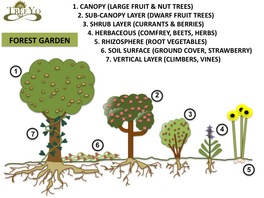
A food forest (or forest garden) is an ancient agricultural concept that mimics nature in all its glory. We’re not talking a vegetable garden here. Instead, a food forest is a largely self-maintaining whole and inclusive, interdependent and highly productive system of multi-storied trees, shrubs, grasses, flowers, pollinators, soil, water and inhabitants.
http://www.transitionnetwork.org/projects/permaculture-restablishing-native-food-forest
A food forest is an efficient, diverse, beautiful ecosystem that is gardening "like the forest". Forest gardeners adapt their design to focus on meeting human needs in a small space. Edible forest gardening expands our horizons of food gathering from field to forest, and everything in between.
Way back in the day......Native Americans foraged in the woodlands all around our location, here at the Farm. From the diverse, native plant life they would collect Elderberries, Ground Cherries, Muscadine Grapes, Northern Pecans, PawPaws, Persimmons, Raspberries, Wild Asparagus and more. Join us as we design & re-establish Native Food Forests. and other permaculture plantings at Sycamore Spring Farm and beyond.
The land has a natural tendency to revert back and become forest. We guide the natural progression with a consciously designed ecosystem of mutually beneficial plants and animals intended for human food production. These intentional ecosystems provide many benefits.
Forest gardeners often talk about the Seven Story Garden. The layers or stories make up the food forest and are identified as follows:
- Tall Tree layer: an overstory of multifunctional fruit and nut trees (apple, pear, plum, chestnuts, pinyon, etc.) and/or nitrogen fixing trees (locust, mesquite, alder, acacia, etc.)
- Low Tree layer: dwarf fruit and nut trees and/or naturally small fruit trees (nectarine, almond, peach) and/or flowering and nitrogen-fixing trees (dogwood, mountain ash, mountain mahogany)
- Shrub layer: flower and fruiting shrubs (blueberry, rose, wolfberry, currents, gooseberry, Siberian pea shrub)
- Herb layer: these are perennial non-woody plants such as vegetables, flowers, kitchen herbs and soil building plants.
- Ground cover layer: low-growing plants that offer food or habitat and that push their way into the empty edges and spaces between plants. (strawberries, nasturtium, clover, thyme, etc)
- Vine layer: these are plants that will climb the trunks and branches of the trees (grapes, hops, passionflower, honeysuckle, squash, cucumbers, melons, etc.)
- Root layer: these are the shallow rooting foods (garlic, onions, radish, carrots, etc.)
